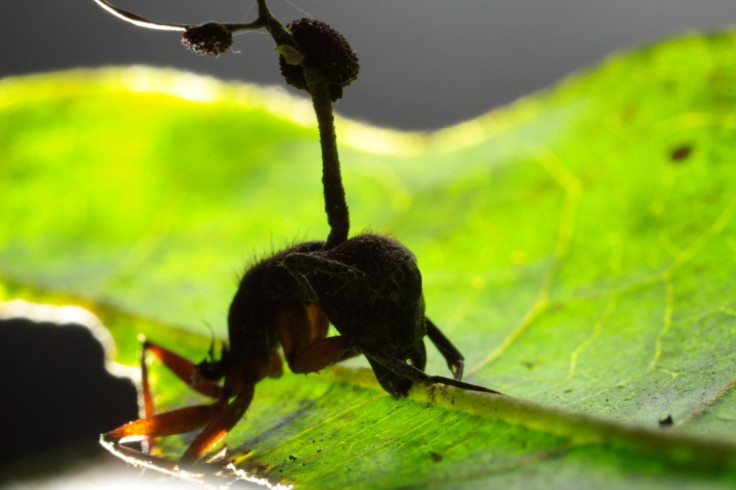Fungus-Controlled Zombie Ants Adapted To Climate Change: Study

We all know about zombie ants or those species of carpenter ants that are infected by a parasitic fungus and lose control of their actions. The parasite, called Ophiocordyceps unilateralis, takes over the body of the ant and compels the insect to venture out of its arboreal home and head into the forest so that it could grow and spread to other victims.
Under the impact of the fungus, the ant clings onto aerial vegetation and as this happens, the parasite starts to grow within its body, eventually piercing its head to release fungal spores on those below. The entire process is pretty rough and has received a lot of attention from the scientific community. But in a new study, scientists have shown how these ants were affected by climate change.
After studying three different regions, scientists from Pennsylvania State University noted zombie ants bite leaves as well as twigs depending on where they are working.
“In tropical areas, zombie ants bite onto leaves, but in temperate areas, they bite twigs or bark,” David P Hughes, associate professor of entomology and biology at the university said in a statement.
The insects, as the researchers noted, adapted to local conditions. Tropical regions remain evergreen throughout the year, so there is no problem for the ants to bite on the leaves there.
“But in temperate areas, the trees are deciduous and lose their leaves in the fall,” Raquel G. Loreto, a postdoctoral scholar in entomology, Penn State, said in the statement. “There, the ants bite onto twigs” to ensure the continuation of their work.
In the study, the group used a 47-million-year-old zombie ant fossil to give critical insight into this adaptation and how it started. The remains, found in Germany, showed the ant was biting onto a leaf. As during that particular time, evergreen forests ranged nearly from the equator to the North and South Pole, the fossil helped the researchers posit that leaves would have been the favorite home for zombie ants.
However, as temperatures declined in the ensuing years and temperate forest coverage increased in the northernmost and southernmost parts of the world, the zombie ants living in those areas would have lost their homes as leaves withered and fell, the researchers added. This would have affected the reproduction process of the sinister fungus, prompting it to evolve and bite onto twigs or barks to ensure survival till today.
“Some of the ants do not simply bite the twigs, but wrap their back legs around the twig and hold on,” Loreto said of the ants. “They probably do this because biting twigs in not enough to hold them on.”
Further genetic analysis revealed both of these features evolved independently in zombie ants in order to adapt the fungi to temperate vegetation.
Among other things, the group also determined zombie ants’ ability to bite twigs evolved at different times in various locations — in this case, in North America and Japan.
“We can estimate that these changes occurred between 40 and 20 million years ago. However, because of the scarcity of zombie ant fossils, we can't be any more specific than that at the moment,” Hughes added. “What is remarkable here is that we have shown that the complex manipulation of an animal by microbe has responded to selection pressure the climate imposes on animals and plants. That was a cool finding that really excited us.”
© Copyright IBTimes 2024. All rights reserved.





















